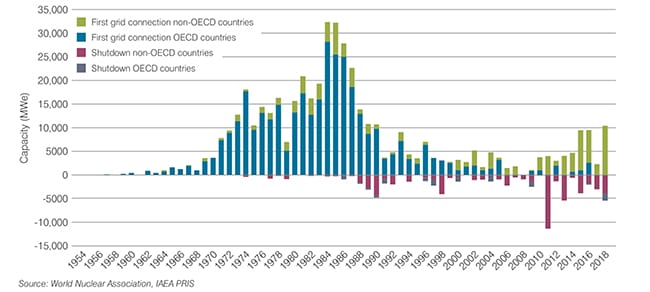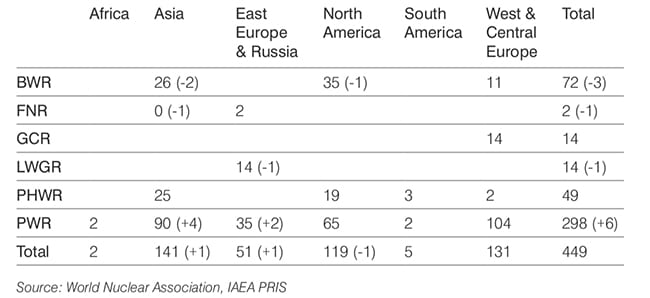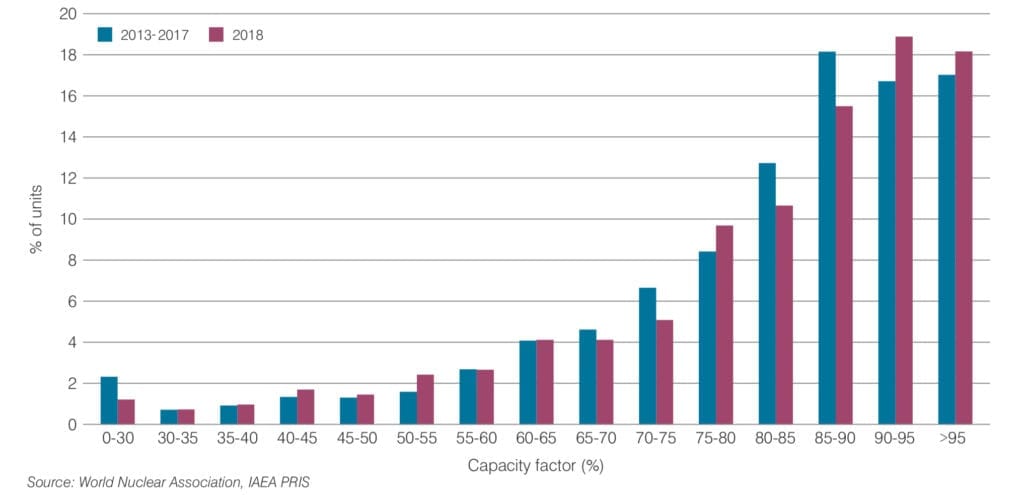
Median construction times for reactors since 1981. Courtesy: WNA, World Nuclear Performance Report 2019
5. The outlook isn’t so bright in ‘mature’ markets.
The WNA noted that a number of factors—both internal and external – “are creating profound challenges for nuclear power in some of its most mature markets.” More than half of the world’s 449 reactors were in the U.S. and Europe, where “despite the vital importance of nuclear to achieving sustainable energy goals, reactor retirements continue to outpace capacity additions.”

Capacity of OECD and non-OECD first grid connections 1954-2018. Courtesy: WNA, World Nuclear Performance Report 2019
Already in 2019, eight reactors have been shut down, five in Japan (Genkai and Daini 1-4), one in Taiwan (Chinsan 2), Bilibino 1 in Russia, and Pilgrim 1 in the U.S. Only four new connections have been made to the grid: Shin Kori 4 in South Korea, Novovoronezh II-2 in Russia, and Taishan 2 and Yangjiang 6 in China.
The report outlines a list of developments that indicate a general long-term slowdown for the sector in developed countries. WNA’s Rising pointed to threats “from distorted and challenging market conditions” for some of these developments.
For example, while France postponed plans to reduce nuclear power’s share in its generation mix from 75% to 50%, Germany is pushing forward with a nuclear phase-out, though its seven operational reactors are frequently operating in load-following mode. In the U.S., “despite its laudable operational performance,” cheap natural gas and a proliferation of renewables have rendered reactors uneconomic, and some of the country’s largest nuclear generators have sought—and won—state support in Illinois, New York, Connecticut, New Jersey, and Ohio to keep reactors on the grid.
In Japan, though the country wants nuclear to make up 20% of its energy supply by 2030, restarts have been slow. In Canada, where 10 of its 19 reactors are slated to undergo refurbishment to extend their operating lifetimes by up to 35 years, the government is also pushing accelerated deployment of small modular reactors (SMRs), the WNA noted.
6. Majority of new startups are in non-OECD countries.
The majority of reactor capacity built between 1970 and 1990 were in West and Central Europe and in North America. Since that period the majority of reactor startups have been in Asia, with first grid connections in East Europe and Russia also contributing to new global capacity, the WNA noted.
At the beginning of 2019, China had 46 operable nuclear reactors, connecting a record 8.3 GWe of new nuclear capacity—“the second largest annual increase achieved by any country since the advent of civil nuclear power,” the report notes. In India, seven reactors were under construction at the start of 2019—a combined capacity of 4.8 GWe—and it has plans to build many more. In January 2019, “the country’s minister of state for the Department of Atomic Energy and the Prime Minister’s Office told parliament that the country planned to bring 21 more reactors online by 2031. The 21 units will be a mix of indigenous and imported reactor designs,” the report says.
Plans to build new reactors are also underway in Bulgaria, which is looking for investors to restart construction at the stalled Belene project; Poland; Egypt; and Saudi Arabia. Argentina just brought online the Embalse nuclear power plant following three-year upgrade program, and in Brazil, the government is working to extend Angra 1’s lifetime to 60 years while considering resuming construction at Angra 3.
7. The WNA has set a ‘Harmony’ Goal Calling for 25% of the world’s power mix to come from nuclear by 2050.
In December 2018, the WNA rolled out the “Harmony” program, a global initiative of the nuclear industry that “provides a framework for action, working with key stakeholders so that barriers to growth can be removed.” The seeks to generate 25% of the world’s electricity by 2050—which would mean the world will need to build 1,000 GWe of new nuclear capacity over the next 30 years. “This is an ambitious target, but the rate at which new reactors will have to be built is no higher than what has been historically achieved,” it said.
“To achieve this, new nuclear capacity added each year would need to accelerate from the current 10 GWe to around 35 GWe for the period 2030-2050. Those countries operating nuclear power plants should commit to continue to do so and those countries with recent experience of new nuclear build should commit to a rapid expansion of their construction programmes to deliver significant new nuclear construction from 2025,” the WNA added.
Nuclear generation can be expanded fast enough to combat climate change, it suggests. “During the rapid expansion of nuclear generation in France in the 1980s and 1990s, most reactors were built in six to seven years. In recent years in China, nuclear reactors have been frequently constructed in around five years,” it said.
However, it will take a “commitment to a substantial expansion of nuclear generation would deliver the benefits of series construction, including faster and lower cost construction,” the WNA acknowledged.
—Sonal Patel is a POWER senior associate editor (@sonalcpatel, @POWERmagazine)

